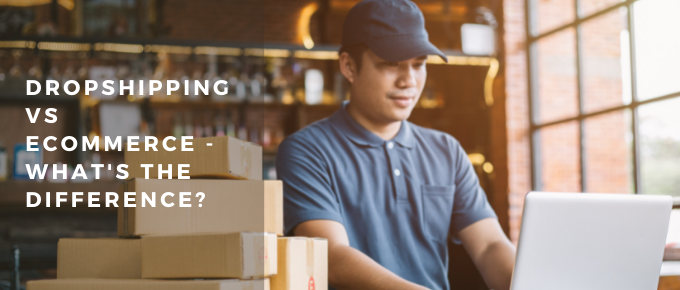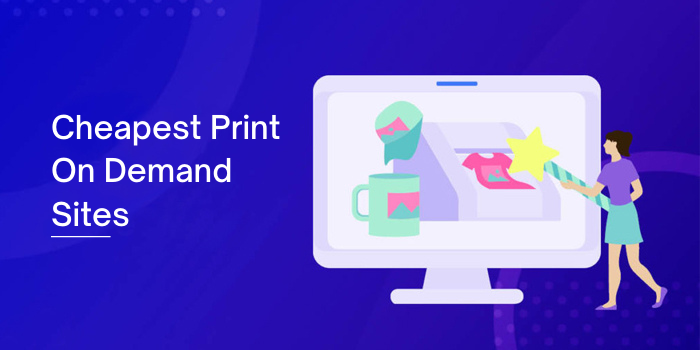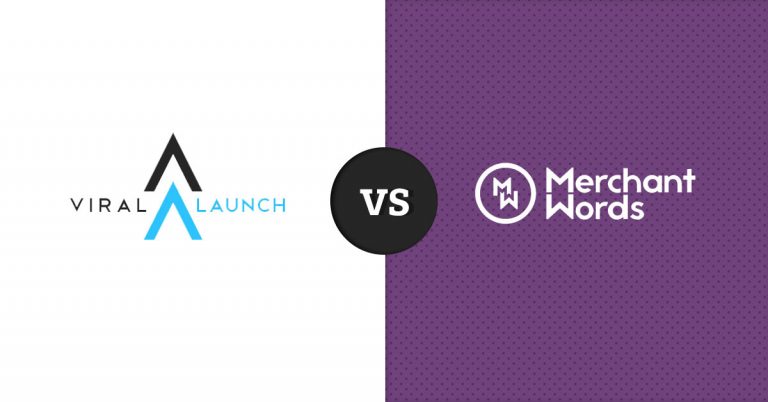
As humans, buying and selling is a way of life. That life is now part of the internet as eCommerce, a $4.28 trillion industry expected to reach $5.4 trillion in the next year.
Dropshipping, a unique business model that has emerged out of eCommerce’s dominance, is currently a $128.6 billion industry set to reach $476.1 billion in 2026.
Those are impressive numbers, and when you consider the internet continues to grow, the potential is even more exciting.
Dropshipping and eCommerce represent massive opportunities for entrepreneurs and small business owners. However, there is some confusion about them.
In this post, we will break down the differences between dropshipping and eCommerce. We will also look at how eCommerce and dropshipping works, with the advantages and disadvantages of each strategy.
What is Dropshipping?
Image taken from: Pexels
As mentioned earlier, dropshipping is a business model that grew out of eCommerce. It is a middleman business that involves retailers that sell goods without handling or processing inventory.
The inventory is with a third-party supplier. It could be an eCommerce platform, a manufacturer, or a wholesaler.
It is the online equivalent of walking into a retail store, ordering a good, and getting it delivered by someone from a different store.
A dropshipping business, like these physical stores, has similar operations to standard eCommerce businesses. They build a branded website with eCommerce capabilities, market the product, and manage customers.
The only thing dropshippers don’t do is hold inventory and deliver to customers.
They still enjoy all the benefits of eCommerce, such as 24-hour service and customer ability to place orders from anywhere with a few clicks.
This business model has been on the rise for a variety of reasons. Mostly though, it is due to the low barrier to entry. With dropshipping, you don’t have to pay for the unit until a customer buys one.
What is eCommerce?
Image taken from: Pixabay
Standard eCommerce, on the other hand, is a business model that most people are familiar with. It involves purchasing goods and products in wholesale qualities and selling them online. It also applies if you manufacture your products.
In a standard eCommerce, the retailer holds the inventory of the products they sell and delivers ordered items to customers using their own logistics arrangement.
As a result, with eCommerce, the owner needs a physical space to operate. For a start, this could be a garage or spare room in your home, but as demand increases, you may have to secure a warehouse.
Besides that, an eCommerce retailer still has to handle all other aspects of the business, including developing branded websites with eCommerce capabilities, customer relations.
Overall, standard eCommerce fulfillment is far more involved for owners than dropshipping. It also requires more capital and managerial skills.
Dropshipping vs eCommerce – How do they work?
Image taken from: Pexels
One important thing to know is that dropshipping is A FORM of eCommerce. The defining difference between it and traditional eCommerce is that the seller does not hold inventory.
As a result, there are way more similarities than differences between dropshipping and eCommerce, including how they work.
These differences only exist from the perspective of the business owner. For the consumer, there is no meaningful difference in how they work.
How Dropshipping works
Now that we know what dropshipping is, how exactly does it work? Here is a breakdown of the process.
- The online seller gets a website or marketplace and stocks it with products. Then various marketing tactics are used to attract customers.
- The seller lists the product at a healthy markup. For example, suppose the product costs $1 from the supplier. In that case, the dropshipper lists it on their website at $3 for a $2 profit from the completed sale.
- When a consumer places an order on the dropshipper’s website, the dropshipper receives a notification and forwards the order details to the supplier. Depending on the platform, this process could happen automatically or manually.
- Depending on the arrangement, the supplier fulfills the order and ships it to the customer with their brand or dropshipper’s name.
At its core, running a dropshipping business means advertising products for a supplier and marking up the price for a slice of the profit.
How eCommerce works
You should know that eCommerce captures all forms of goods and services traded online. While dropshipping primarily involves physical goods, you can sell services under an eCommerce system too.
However, for this blog, we will stick to physical products. Here is how it works in standard eCommerce.
- The online seller acquires inventory. It could be a singular product or different kinds of products.
- Then, they set up a branded website or sign up to a marketplace where they list their product and available quantity. The seller also uses marketing tactics to attract customers to the website.
- When a customer orders from the merchant’s website, the seller receives a notification. Then the merchant fulfills the order.
- Finally, on their own or via a logistics partner, the business owner sends the product directly to the customer under the business’s brand name.
As you can see, under eCommerce fulfillment, the seller has complete control over every aspect of the business process. This model, like dropshipping, has its advantages and disadvantages.
Pros and Cons of Dropshipping vs eCommerce
Image taken from: Pexels
While there are certainly those who swear one is better than the other, either strategy comes with its perks and drawbacks. A lot of people have found success (and failure) with dropshipping, as have standard eCommerce.
Here is a closer look at the benefits and negatives of both business models.
Advantages of Dropshipping
The obvious and fundamental benefit of dropshipping is the low barrier to entry. It is relatively easy to get started. There is no need to buy inventory, except for samples that you might need for marketing purposes.
In terms of cost, it is exceedingly affordable to start a dropshipping business. The only significant investment is the cost of setting up a branded website and running ads. This makes dropshipping a fast-track method for anyone who wants to become an online retailer.
Also, there is a broader room for experimentation because the overhead is low, and there is minimal financial risk. You can try out different advertising methods and products to see what works and what doesn’t.
Besides experimentation, dropshipping provides more flexibility to react and adapt to consumer trends. When consumers are no longer interested in Product A, you can pivot quickly to the in-demand Product B without incurring any loss on stocking Product A.
Another advantage of dropshipping is it is far easier to scale. You can take on as many orders as possible because you are not limited to a physical space.
When your order numbers increase, the responsibility is on the supplier to increase their capacity and maintain an efficient delivery. Nothing has to change at your end. You don’t even have to hire extra staff.
Disadvantages of Dropshipping
The biggest disadvantage of dropshipping is also its primary advantage – you don’t hold inventory. Dropshippers have zero control over the packaging, quality of the final product or supply chain.
Since these factors are central to customer satisfaction, it means the long-term viability of a dropshipping business is entirely out of the merchant’s hands.
The lack of control over the supply chain also makes it challenging to build a brand. Even if the product delivers as advertised, the praise typically goes to the product’s brand instead of you.
Another disadvantage is the low-profit margin. The profit in dropshipping lies between the price you advertise to consumers and the price suppliers charge you. Because you aren’t getting bulk pricing as suppliers charge per order, there is little room for a reasonable markup.
To stay competitive, dropshippers, especially new merchants without an established brand, have to cut into their sales prices.
There are also possible legal problems to consider. Not every supplier is legit, regardless of what their marketing says. Thus, it is not always easy to know how and where they get their supply.
A typical example is suppliers that illegally use another company’s intellectual property or a trademarked logo. While the dropshipper may not know about this, as the vendor, they are automatically complicit.
That is why it is crucial to invest time and resources into research when choosing suppliers.
One more thing, despite the widespread impression, a lot of work goes into dropshipping. Managing the website and sales order, marketing, and advertising are all business aspects you have to handle. These take a lot of time or money if you outsource the responsibility.
That is a significant investment for a business with little to zero control over the quality of the product. If the package gets damaged or delivery takes time, you are at the mercy of the supplier.
Considering customer satisfaction is paramount, a string of bad experiences could end a dropshipping business before it takes off.
Advantages of eCommerce
Image taken from: Pexels
The flaws of dropshipping are standard eCommerce’s gain. With near-total control over the supply chain, merchants can confidently set return policies and use fulfillment speed in their marketing.
Since you get to choose your delivery partner, you can set the terms of agreement, from the priority of your orders to the average delivery time.
Suppose the logistics partner fails to meet your expectations. In that case, you are free to switch to another without worrying about losing product supply. You can even add a delivery component to the business and do it all in-house.
This gives you the foundation to build a brand. When you source or manufacture your products with unique packaging and excellent customer service, you can grow your brand and amass a large base of loyal customers.
Also, all credit goes to you because your brand is the only thing customers interact with throughout the order and delivery process. You can then use these positive reviews to promote your products without worrying about appropriated identity or any legal constraints that come with using customer reviews in dropshipping.
All of these provide an opportunity to scale to massive heights and build an international business. You also get to source products at wholesale prices that lower the cost of running the business.
Ultimately, this leads to a larger share of the profit pie. Without splitting with a supplier, you get to set your profit margin, well over the 20% average that goes to dropshippers.
Finally, because you have complete control, the long-term existence of your traditional eCommerce fulfillment business does not rely on the mercy of suppliers. Failure or success of the enterprise is in your hands.
Disadvantages of eCommerce
Those are a lot of advantages to eCommerce, but it is not without its drawbacks. The most significant being the reason dropshipping is attractive to many, and that is capital.
eCommerce fulfillment requires setting up the standard online storefront, but merchants also have to buy inventory before securing a customer. This comes with significant financial risk because there is always a possibility that the business won’t attract enough customers to justify its existence.
Even when there is substantial initial interest, it is not guaranteed to last. Customers will also not necessarily buy other products you try to sell. To a large degree, running a regular eCommerce business means being prepared for some losses.
However, if the product proves a hit and the business takes off, there is little time to learn on the job. The beauty of eCommerce is you can go from needing a garage to requiring a warehouse in a few months or even weeks.
Scaling like this comes with growing pains. You need to be ready to acquire more products quickly and have a physical space to store them. It requires a lot of business planning, staff, and store management, skills that take years to master.
If you plan on making it a sustainable source of income, you will have to hire people to help with day-to-day operations. That means extra costs. However, you have complete control over expenses, so you can manage your growth as you like.
Differences between Dropshipping and eCommerce
Here is a table summarizing the pros and cons of both business models.
eCommerce vs Dropshipping – Which one is right for you?
Image taken from: Unsplash
So far, we’ve discussed the differences between dropshipping and eCommerce, how each model works, and their respective benefits and negatives. So, which should you choose?
Let’s start with eCommerce.
eCommerce
eCommerce requires a significant amount of capital. If you have the necessary amount of resources, it is a viable option. But simply having the money is not the only reason why one should choose eCommerce fulfillment over dropshipping.
It also requires time and a lot of work. Building a website, deploying various marketing tactics, and developing a brand are time-consuming actions that require a committed approach. You don’t have to know every aspect of the process since you can hire a specialist.
Still, you need to pay enough attention to understand what works and doesn’t while managing your expenses.
So, if you’ve got time, startup capital, and hope to build a successful retail business, eCommerce is worth considering.
Dropshipping
Since practically half of the business process is outsourced, dropshipping is a good idea for anyone low on time and resources. It is a viable option for students and low-income earners who want a side hustle or a way to build up funds for a traditional eCommerce business.
It is also an attractive option for digital nomads. Scaled or not, dropshipping requires the same level of effort and resources. You can run the business from anywhere without compromising on your lifestyle.
Dropshipping is also an inexpensive way for young marketers and SEO professionals to gain practical experience with market trends and online advertisements.
Finally, you don’t have to choose between both. You can combine eCommerce fulfillment and dropshipping to service customers, build a brand, and explore different markets without overly committing financially.
Conclusion
Those are the differences between dropshipping and eCommerce. Whichever option you choose, there are plenty of reputable platforms that support both models. You can build your online storefront on places like Shopify, Amazon, AliExpress, Magento, and eBay.
Dropshipping and eCommerce are excellent ways to make money online, and the best option depends on you and your business goals.
As long as you’ve got the right product, branding, and an effective marketing plan, you can find success with either model.












